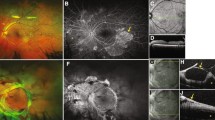Abstract
A simple reproducible model for the creation of tractional retinal detachments in rabbits is presented. This model comprises retinal membranes composed of different cell types derived from ocular tissues, and eliminates the need for lengthy and expensive tissue culturing procedures. The injected cell bolus rapidly migrates to the optic disc and forms surface retinal membranes. These lead to tractional retinal detachment confined to the area of the vascular medullary rays. The rapidity and severity of the clinical process seems to be directly dependent upon the number of cells injected. Good visibility of the posterior pole is maintained throughout the course of the development of detachment.
This model is acceptable for testing agents to suppress intraocular cellular proliferation. It can also serve to teach surgical techniques for the management of vitreo-retinal membranes without endangering human eyes.
Zusammenfassung
Es wird ein einfaches, reproduzierbares Modell zur Erzeugung einer Traktionsamotio bei Kaninchen vorgestellt. Dabei werden epiretinale Membranen, die von unterschiedlichen okulären Zelltypen abstammen, gebildet und so die Notwendigkeit langdauernder und kostspieliger Gewebekulturen eliminiert. Der injizierte Zellbolus wandert schnell in Richtung Papille, bildet Membranen auf der Netzhautoberfläche, und führt dann zum Auftreten einer Traktionsamotio, die auf das Gebiet der vascularisierten Markstrahlen beschränkt ist. Die Schnelligkeit und Schwere des klinischen Verlaufes scheint direkt proportional zur Zahl der injizierten Zellen zu sein. Während der gesamten Entwicklung der Traktionsamotio bleibt der Einblick auf den hinteren Augenpol ungestört.
Dieses Modell eignet sich zur Testung von Mitteln zur Unterdrückung intraokularer Zellproliferation. Außerdem bietet es die Möglichkeit, chirurgische Techniken zur Behandlung vitreo-retinaler Membranen zu lernen, ohne dabei menschliche Augen zu gefährden.
Similar content being viewed by others
References
Abrams GW (1980) Retinal detachment induced by retinal pigment epithelial cells (personal communication)
Algvere P, Kock E (1976) Experimental fibroplasia in the rabbit vitreous, retinal detachment induced by autologous fibroblasts. Albrecht von Graefes Archiv Klin Ophthalmol 199:215–222
Cleary PE, Ryan SJ (1979) Experimental posterior penetrating eye injury in the rabbit. I. Method of production and natural history. Brit J Ophthalm 63:306–311
Constable I, Tolentino FI, Donovan RH, Schepens CL (1974) Clinical pathologic correlation of vitreous membranes. In: The Retinal Congress (Eds RC Pruett and ChDJ Regan) pp 245–257. Appleton-Century Cross, New York
Foos RY (1974) Vitreo-retinal Juncture; Simple epiretinal membrane. Albrecht von Graefes Archiv Klin Ophthalmol 189:231–250
Gabbiani G, Hirschel BJ, Ryan GB, Stakou PR, Majnog G (1972) Granulation tissue as a contactile organ. Jour exp Med 135:719–734
Machemer R, Laqua H (1975) Pigment epithelial proliferation in retinal detachment (massive periretinal proliferation). Amer J Ophthal 80:1–22
Machemer R (1978) Pathogenesis and classification of massive periretinal proliferation. Brit J Ophthalm 62:737–747
Mueller-Jensen K, Machemer R, Azarina A (1975) Autotransplantation of retinal pigment epithelium in intravitreal diffusion chamber. Amer J Ophthal 80:530
Numata T, Constable IJ, Whitney DE (1975) Physical properties of experimental vitreous membranes I. Tensile strength. Invest Ophthal 14:148–152
Peacock EE, Van Winkle W (1970) Surgery and biology of wound repair, p 49, Saunders, Philadelphia
Roth A, Foos RY (1973) A system for the macroexamination of eyes in the laboratory. Amer J of Clin Path 59(5):674–683
Tano Y, Sugita G, Abrams G, Machemer R (1980) Inhibitation of intraocular cellular proliferation with intravitreal corticosteroids. Amer J Ophthal 89:131–136
Topping TM, Abrams GW, Machemer R (1979) Experimental double perforating injury of the posterior segment in rabbit eyes, the natural history of intraocular proliferation. Arch Ophthal 97:735
Author information
Authors and Affiliations
Additional information
This investigation was supported in part by the Wasserman Professorship Fund
Rights and permissions
About this article
Cite this article
Trese, M.T., Spitznas, M., Foos, R.Y. et al. Experimental tractional retinal detachment in rabbits. Albrecht von Graefes Arch. Klin. Ophthalmol. 214, 213–222 (1980). https://doi.org/10.1007/BF00417516
Received:
Issue Date:
DOI: https://doi.org/10.1007/BF00417516




